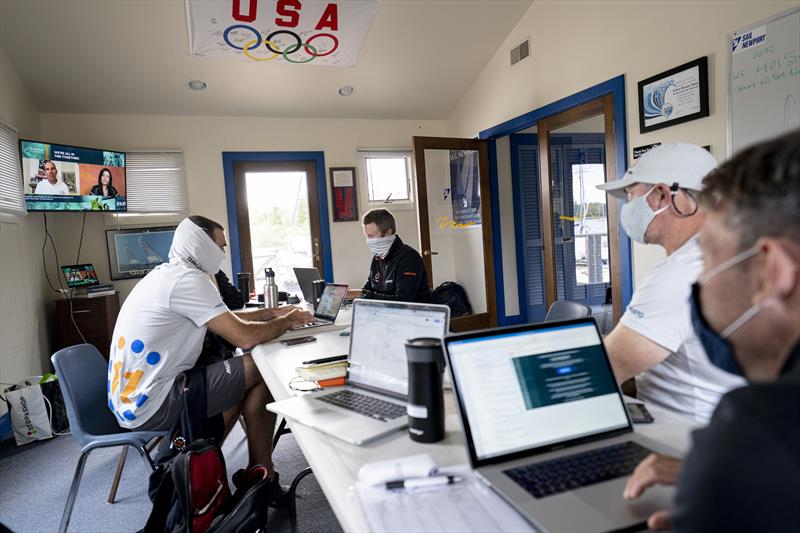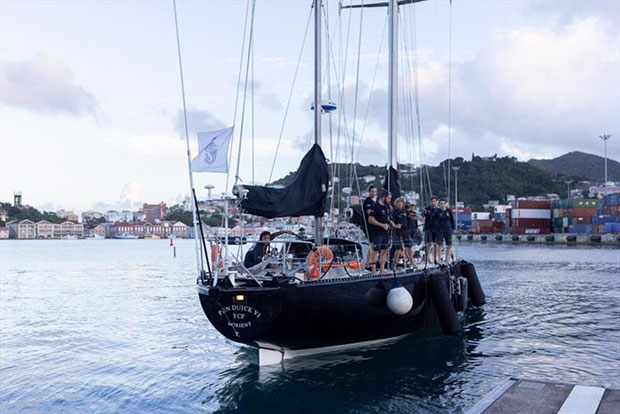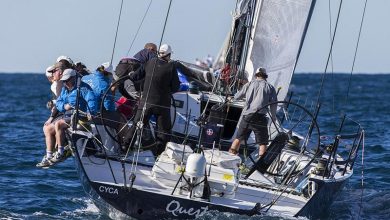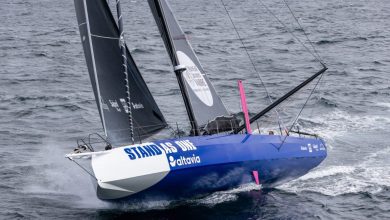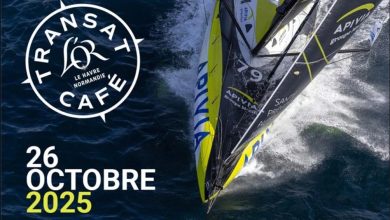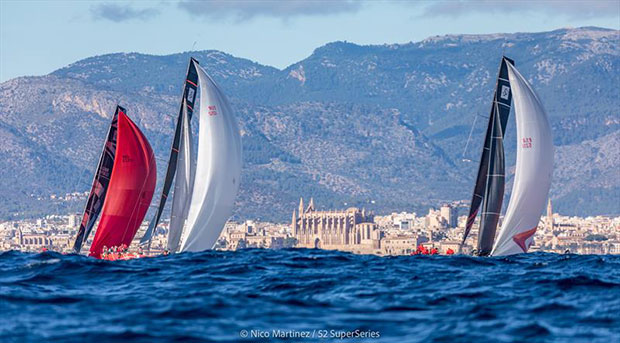11th Hour Racing’s new IMOCA 60
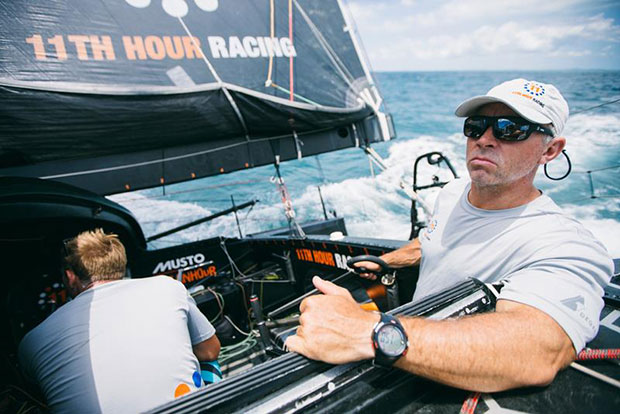
While the next edition of The Ocean Race (nee The Volvo Ocean Race) isn’t slated to begin until October of 2022, some teams that will be racing aboard IMOCA 60s are already deep into the design and build process of their new steeds. 11th Hour Racing Team falls into this camp.
The team is being led by CEO Mark Towill, skipper Charlie Enright , both of whom are veterans of the last two editions of the Volvo Ocean Race, and the team’s roster includes several high-profile crewmembers including Kyle Langford, Simon Fisher and Rob Greenhalgh. Given this talent level, it’s not surprising that the team is gunning to create a fast and highly competitive boat, nor is it surprising —given their environmentally focused sponsor—that they are aiming at building a machine that can win legs while also serving as a model for sustainability for the IMOCA 60 class and for The Ocean Race.
The 11th Hour Racing design team is being led by Guillaume Verdier, a designer whose yachts have won the America’s Cup, four Vendee Globe races, and various round-the-world records in the Ultim class of maxi trimarans. He was also one of the head designers behind the all-conquering Comanche, as well as plenty of other high-profile designs that Sail-World readers are likely familiar with.
The team’s new boat is under construction at CDK Technologies in Lorient, France, and the team has also contracted the services of François Gabart’s (a former Vendee Globe winner and highly successful Ultim skipper) MerConcept, which will handle some of the technical and performance-related aspects of the new build.
Additionally, the team has named Damian Foxall, a ten-time round-the-world racer and former Volvo Ocean Race winner, and Amy Munro, who was involved with the British-flagged challenge for the 35th America’s Cup (2017), as its sustainability managers. The goal, says the team, is to compete in the 2022-2023 edition of The Ocean Race while having a neutral impact on the environment.
I checked in with Towill, via email, to learn more about the team’s new IMOCA 60 design and build process.

Mark Towill and Charlie Enright of 11th Hour Racing – photo © Image courtesy of Amory Ross/11th Hour Racing
From an organizational standpoint, how much harder is it to plan and incorporate a new-build project on top of building a team to compete in The Ocean Race, compared to your last two races using a One Design boat? Also, is this offset by the fact that there are significantly fewer crew members involved this time, compared to your last two laps?
One Design certainly has its benefits but with the introduction of the new class within The [Ocean] Race, it brings a whole new dimension – a return to the race’s DNA with design, technology and innovation back in the heart of the Race. And after two laps in the VO65, it’s an exciting development for us as a team.
We are fortunate to have a long runway in the build-up to the race in 2022-23, so [we] are able to be out training each week, while we also have time shoreside working with the data in our simulator to look at foil designs.
Despite [having] less crew, we all know our roles and each have different responsibilities. Charlie takes the lead on the development of the boat with Guillaume [Verdier] and Mer Concept in France, and I lead on the overall running of the team and managing the sponsorship and our partners.

Designer Guillaume Verdier discussing 11th Hour Racing Team’s new IMOCA 60 boat design for The Ocean Race 2022-23. – photo © Amory Ross / 11th Hour Racing
Can you please give us some insight on why the team decided to build the new boat in France, rather than in Rhode Island? Also, does this present tough logistical challenges for the team as far as travel restrictions to and from the EU go for Americans during the pandemic?
We want to win The Ocean Race in 2022-23, and to give us the best possible chance of doing that, we need to build a new IMOCA 60. The global experts in the design, build and performance testing of boats in the [IMOCA] class are all based in Brittany, France, so it made absolute sense to work with them on their home soil.
We started our boat build in June 2019 before the pandemic hit, and although we haven’t been able to visit these past seven months or so we are in daily contact. We’re very keen to bring all the knowledge we have learnt over the past 18 months or so back Stateside and to Rhode Island in particular.
The pandemic has brought some logistical challenges, however bringing the [training] boat back to Newport in August was very important and we have had a seven-week training session here.
I know that the team has logged a lot of training miles on your older-generation IMOCA 60—can you tell us about a few things that you learned from the old boat that you plan to incorporate into the design and build of the new boat?
Our main focuses have been on liveability. These boats are so uncomfortable and have minimal living space for a solo sailor, let alone [in their] fully crewed [configuration]. The other main focus has of course been on testing different foil designs and concept control systems.
Without getting into a lot proprietary knowledge, what is consuming more design time and consideration—the hull form or the foils?
The hull form is complete, so the focus now is on foils and systems.
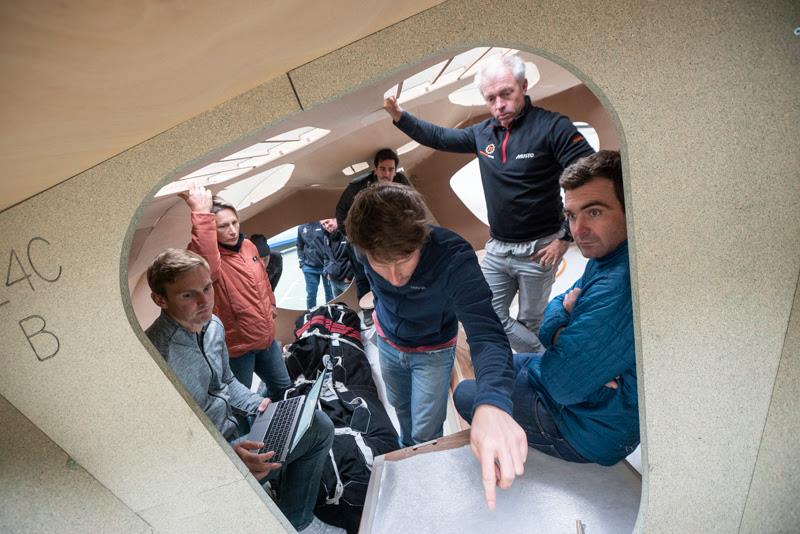
11th Hour Racing Team visit the cockpit mock-up for their new IMOCA 60 being build for The Ocean Race 2022-23 – photo © Amory Ross / 11th Hour Racing
In terms of crew living space, what have been some of your biggest design considerations and decisions?
These boats are incredibly uncomfortable to be down below in—the live-ability is really challenging. There’s little space and when you do manage to get your head down, it’s virtually impossible to sleep due to the [boat’s] movement. We’ve been looking at ways to make it as comfortable as possible with a full crew onboard.

11th Hour Racing Team visit the cockpit mock-up for their new IMOCA 60 being build for The Ocean Race 2022-23 – photo © Amory Ross / 11th Hour Racing
Can you tell us what Francois Gabart and MerConcept have brought to the table in terms of designing the new boat?
They have brought to the table an incredible amount of experience. They designed, built and launched Apivia, which burst straight out of the starting blocks going on to win the TJV in November [2019]. And their design and engineering team expands beyond IMOCAs with their multihull and Ultime experience as well.
They have really embraced our sustainability principles and are a great team to work with.
Will you design the new boat so that it can also be converted to shorthanded/singlehanded sailing? If not, do you see the IMOCA 60 class effectively splitting into two subcategories—fully crewed IMAOCA 60s and singlehanded IMOCA 60s?
The boat won’t need any major conversions for short-handed/singlehanded sailing. I don’t see two sub categories developing, more that there will be boats that were originally designed for single-handed or fully crewed, but [these boats] can race competitively against each other.
Can you please tell us about the sustainability initiatives that you and the team are incorporating into this new-build project? Also, can you please tell us about the sustainability standards that your team is helping the IMOCA class to develop?
There are two separate areas where we are working with IMOCA: We are on the sustainability committee of the IMOCA Class Association and supporting the development of their new set of sustainability rules, from [the] Life Cycle Assessment to bio-composite usage and renewables, which will be written in to the Class rules going forward. It’s really positive to see the progress that is being made.
In addition, we are developing a Sustainability Toolbox [that] we will launch in 2021 and [will] feature a range of resources, case studies and practical guides on how to implement a sustainability policy internally at your organization, whether you are a sailing team, event or sports club. [The] IMOCA [class association is] peer reviewing and pilot testing with three teams.
It is often levied at us that it isn’t sustainable to be building a boat and so we shouldn’t be doing it. And yes, that is right—to be the most sustainable team out there, then there should be no activity at all: no sailing, no races, no competition. We should just all stay at home.
But that isn’t the reality of how life is lived: we are a competitive team and we want to win The Ocean Race. So, we are going to build a new boat. But what we challenge ourselves daily with is: how can we do this in the most sustainable way? How can we work with our partners to embed more sustainable practices within materials and processes for future builds? And can we do it in a way that actually leaves a positive impact on the environment? That’s the work our sustainability team is doing day in, day out.
We are really proud that our boat will be a showcase for how working collaboratively on sustainable innovation brings value to us as a team, to our partners, our suppliers and our environment. We have looked at every aspect of the build, from the energy used by the designers’ computers, to the water footprint; the materials that are applied throughout production to the travel of team members to visit the build.
We are gathering data at every point, minimizing any waste, recycling or regenerating where we can, mitigating any impact and also going one step further and leaving a positive impact in our wake.
By working from the inside of the industry, we are able to monitor, recommend and enact change with our build partners, and what we have learnt, they can use with new builds and other teams. By working collaboratively in this way, as an industry, we can make real change going forward.
by David Schmidt

